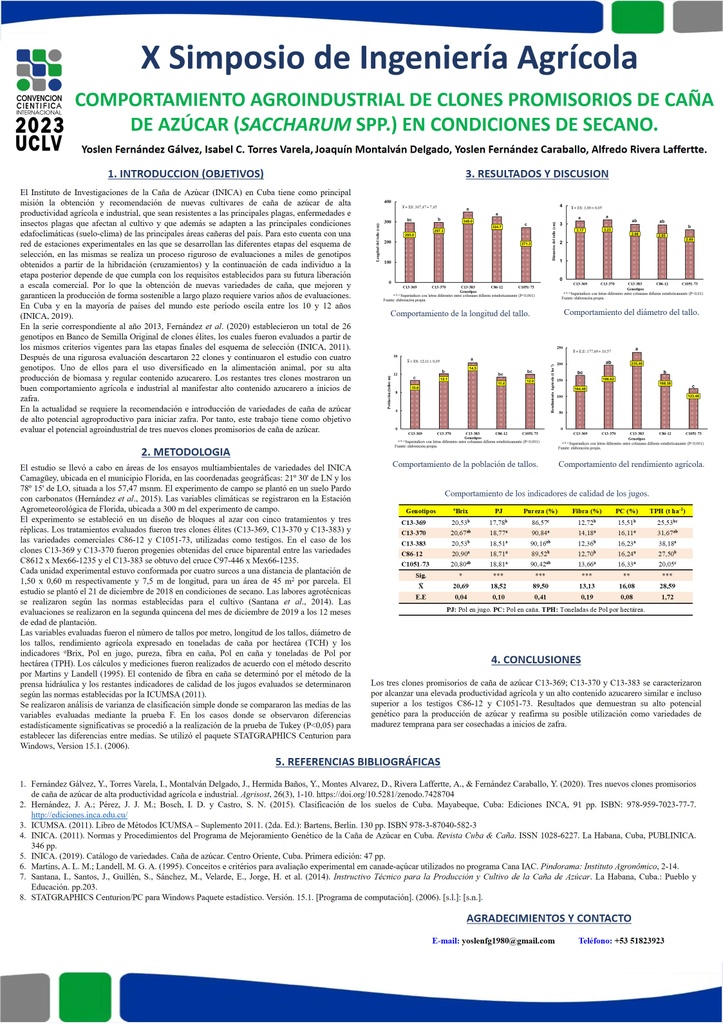Executive Secretary

IX Conferencia Científica Internacional sobre Desarrollo Agropecuario y Sostenibilidad
X Simposio de Ingeniería Agrícola

Resumen
Resumen:
Problemática: en la actualidad se necesitan variedades de caña de azúcar con alto potencial agrícola e industrial a inicios de zafra que permita sustituir aquellas que con muchos años de explotación han disminuido su productividad y resistencia a las principales plagas y enfermedades que afectan al cultivo.
Objetivo: evaluar el potencial agroindustrial de tres nuevos clones promisorios de caña de azúcar.
Metodología: El diseño experimental utilizado fue bloques al azar con cinco tratamientos y tres réplicas. Los tratamientos fueron tres clones promisorios (C13-369, C13-370 y C13-383) y dos variedades comerciales (C86-12 y C1051-73) utilizadas como testigos. Se evaluaron características agrobotánicas y el rendimiento agrícola, así como indicadores de calidad de los jugos a inicios de zafra (diciembre) con 12 meses de edad en el ciclo de cosecha de caña planta.
Resultados y discusión: los clones C13-383 y C13-370 superaron a los testigos con rendimientos agrícolas superiores a las 195 t ha-1 de caña molible y 30 t Pol ha-1. El clon C13-369 mostró valores de rendimiento agrícola (164,48 t caña ha-1) e industrial (25,53 t Pol ha-1) similares a la variedad C86-12 y superiores a la C1051-73.
Conclusiones: los tres clones promisorios poseen un alto potencial genético para la producción de azúcar y reafirman su posible utilización como variedades de madurez temprana para ser cosechadas a inicios de zafra.
Abstract
Abstract:
Problematic: Currently varieties of sugarcane with high agricultural and industrial potential are needed at the beginning of harvest to replace those that with many years of exploitation have decreased their productivity and resistance to the main pests and diseases that affect the crop.
Objective: to evaluate the agroindustrial potential of three new promising clones of sugarcane.
Methodology: a study was carried out under rainfed conditions in areas of the test site for the multienvironmental studies of varieties of the Genetic Improvement Program of the Research Institute of the Sugarcane from Camagüey, Cuba. The experimental design used was random blocks with five treatments and three replicas. Treatments were three promising clones (C13-369, C13-370 and C13-383) and two commercial varieties (C86-12 and C1051-73) used as controls. Agrobotanical characteristics and agricultural yield were evaluated, as well as quality indicators of juices at the beginning of the harvest (December) with 12 months of age in the harvest cycle of cane plant.
Results and discussion: the clones C13-383 and C13-370 exceeded the controls with agricultural yields exceeding 195 t ha-1 of milled cane and 30 t Pol ha-1. The clone C13-369 showed values of agricultural yield (164.48 t ha-1 cane) and industrial (25.53 t Pol ha-1) similar to the variety C86-12 and higher than the C1051-73.
Conclusions: the three promising clones have a high genetic potential for the production of sugar and reaffirms their possible use as varieties of early maturity to be harvested at the beginning of harvest schedule of sugar mill.
Sobre el ponente

Yoslen Fernández

Discussion

